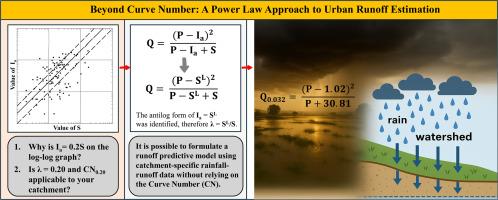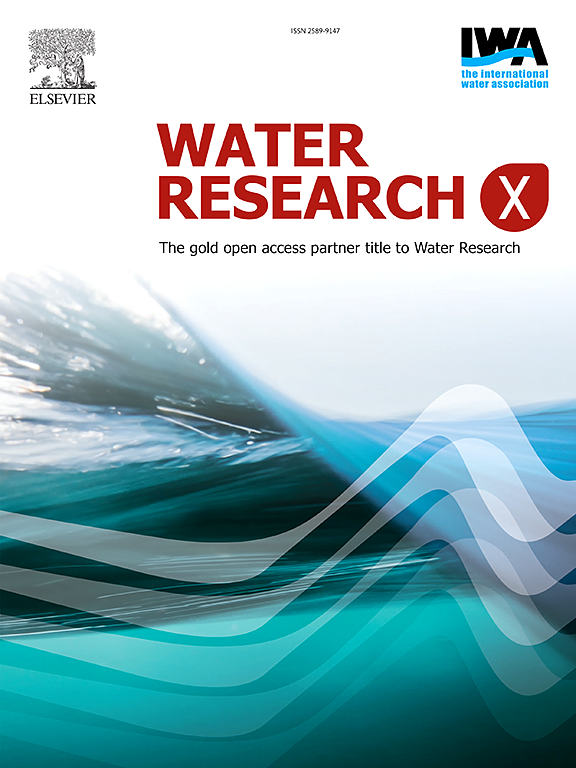超越曲线数方法:基于幂律的校准和增强城市径流估算的非参数方法
IF 8.2
2区 环境科学与生态学
Q1 ENGINEERING, ENVIRONMENTAL
引用次数: 0
摘要
本研究提出了基于统计的自然资源保护局(NRCS)曲线数(CN)降雨径流模型的重新表述,将传统的线性初始抽象(Ia)与保留(S)关系(Ia = λS,其中λ为初始抽象比)替换为基于幂律的表述(Ia = SL,其中L为对数-对数图的梯度),以恢复数学上的准确性。采用非参数偏差校正和加速(BCa)自举框架对NRCS普遍λ = 0.20假设进行了检验,揭示了其在马来西亚城市流域的统计不有效性(在99% BCa置信区间:0.032 - 0.079时推导出最佳λ值)。该模型在保持模型简洁性的同时,提高了径流估计的精度和理论一致性。重要的是,它适应完整的降雨径流数据集,并动态捕获集水区饱和度相关的保留行为,解决了传统CN实践的局限性。新开发的简约双参数(S, L)径流估算模型通过实现流域特定校准而无需任意选择CN,从而确保了实际适应性。这项研究将传统的水文学与现代严谨的统计联系起来,为传统的CN实践提供了一个可扩展的、数据驱动的替代方案。研究结果通过展示非参数方法在改进传统水文模型和更好地捕捉现实世界的非线性和气候条件变化下的可变性方面的潜力,支持径流建模的范式转变。本文章由计算机程序翻译,如有差异,请以英文原文为准。

Beyond the Curve Number methodology: Power law-based calibration and a nonparametric approach for enhancing urban runoff estimation
This study presents a statistically grounded reformulation of the Natural Resources Conservation Service (NRCS) Curve Number (CN) rainfall-runoff model by replacing the conventional linear initial abstraction (Ia) to retention (S) relationship (Ia = λS, where λ is initial abstraction ratio) with a power law-based formulation (Ia = SL, where L is gradient of log-log graph) in order to restore mathematical correctness. A nonparametric bias-corrected and accelerated (BCa) bootstrap framework was employed to test the NRCS universal λ = 0.20 assumption, revealing its statistical invalidity (derived optimum λ value at 99 % BCa confidence interval: 0.032 - 0.079) for the urban Malaysian catchment studied. The proposed model achieved higher theoretical coherence and improved runoff estimate accuracy while preserving model parsimony. Importantly, it accommodates full rainfall-runoff datasets and dynamically captures catchment saturation-dependent retention behavior, addressing limitations of the conventional CN practices. The newly developed parsimonious two-parameter (S, L) runoff estimation model ensures practical adaptability by enabling catchment specific calibration without resorting to arbitrary CN selection. This study bridges traditional hydrology with modern statistical rigor, offering a scalable, data-driven alternative to conventional CN practices. The findings support a paradigm shift in runoff modelling by demonstrating the potential of nonparametric methods to refine legacy hydrological models and better capture real world nonlinearity and variability under changing climatic conditions.
求助全文
通过发布文献求助,成功后即可免费获取论文全文。
去求助
来源期刊

Water Research X
Environmental Science-Water Science and Technology
CiteScore
12.30
自引率
1.30%
发文量
19
期刊介绍:
Water Research X is a sister journal of Water Research, which follows a Gold Open Access model. It focuses on publishing concise, letter-style research papers, visionary perspectives and editorials, as well as mini-reviews on emerging topics. The Journal invites contributions from researchers worldwide on various aspects of the science and technology related to the human impact on the water cycle, water quality, and its global management.
 求助内容:
求助内容: 应助结果提醒方式:
应助结果提醒方式:


